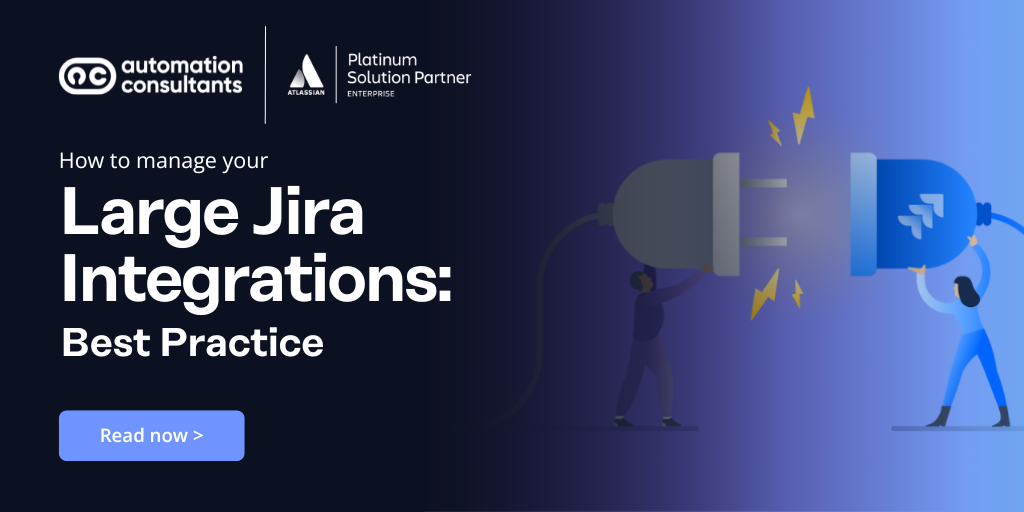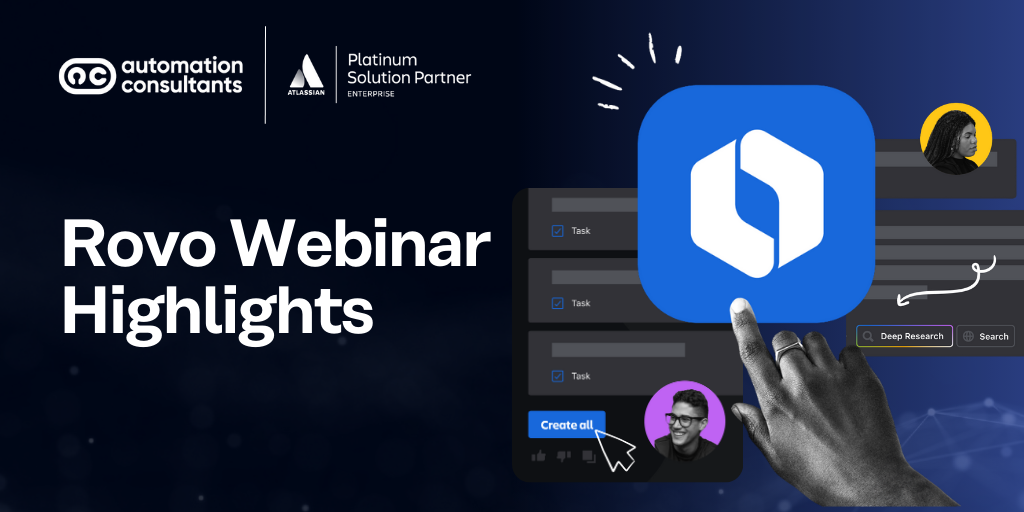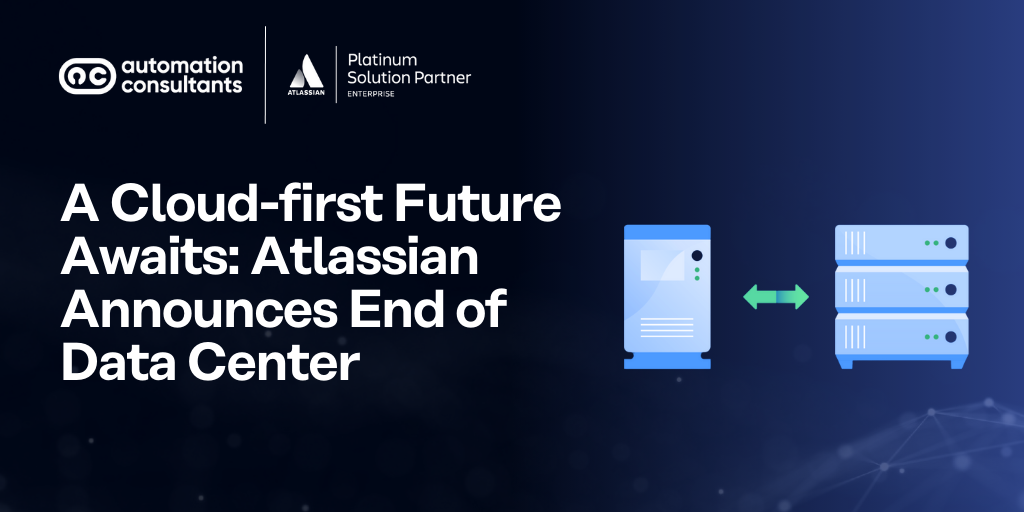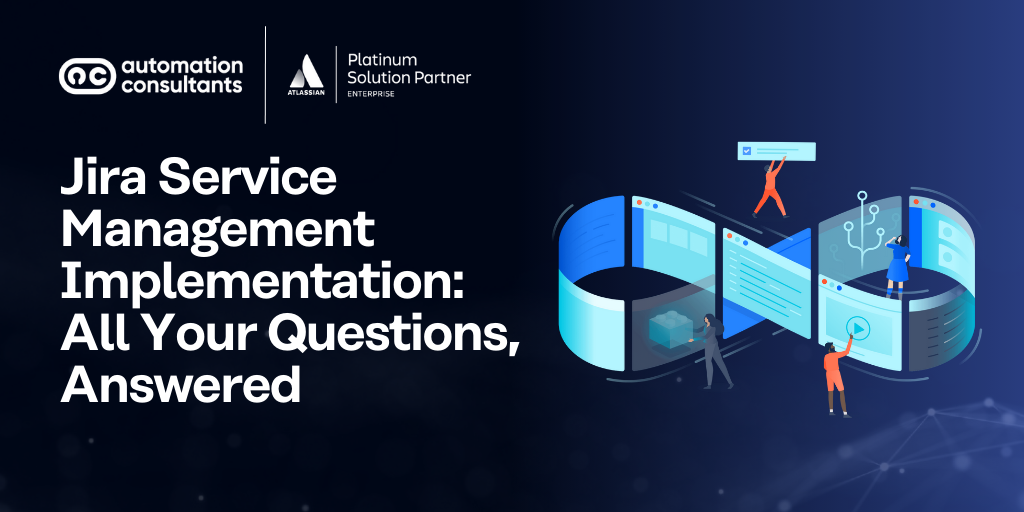If you’ve been following our series on large Jira best practice, you may remember we previously explored how to manage projects and how to handle your Jira infrastructure.
Now we’re back with part three: Managing your large Jira integration platforms.
In this post, we’ll explore:
How to maintain integrations effectively
Spotlight on core integration platforms, such as GitHub or Entra ID (formerly Azure AD)
Best practice for scaling Jira integrations
Let’s begin.
Jira: How big is big?
Typically, we’d define a large Jira instance as one with over 1,000 users and/or more than 150k issues.
However, if you’re a little below that threshold, you may still find some of the guidance and best practice in this piece relevant, particularly if you manage a large number of integrations.
What is a Jira integration?
We’re exploring two kinds of integrations in this piece: Essential platform integrations (like a mailbox), and third-party apps, which extend Jira’s functionality and can be found in the Atlassian Marketplace.
The former facilitate the business-as-usual functions of Jira, such as receiving email notifications, or connecting Jira with your development pipeline.
Third-party apps, meanwhile, can be used to enhance and extend your use of Jira with additional functionality. From test management and time tracking to custom charts and auditing tools, the thousands of apps on the Atlassian Marketplace can help you to shape and strengthen your large Jira instance to meet your specific needs.
How to maintain your integrations effectively
When you’re dealing with a large Jira instance, it’s crucial to keep a tight reign on all the tools and integrations you use. If you don’t, it’s easy for large instances with a high volume of data and users to spiral out of control.
We recognise that this isn’t always easy – particularly if you only have part-time Jira Admins who are juggling multiple requests and tasks – but if you can assign some time to the below recommendations, it can prove hugely beneficial in the long term.
Document a clear integration strategy
It’s important to identify how integrations and third-party apps align with your overall objectives. Users should be clear on how an integration will add value and whether it is appropriate to use with your instance. A documented integration strategy can help to inform this.
Embed a request management process
We’d always recommend that you implement a clear request management process, particularly to handle third-party marketplace apps (as there are so many).
With a high volume of users, integrations can easily spiral out of control. As such, consider only granting permission to integrate a new platform or app to Jira Admins (or other appropriate stakeholders).
Ideally, you’ll have a process whereby users submit a request, detail what purpose the app will fulfil, and provide any additional information required.
You can then refer back to that documented strategy of yours, to ensure that the request aligns with your overall integration objectives and criteria.
💡 Tip!
You could use Jira Service Management (JSM) to handle your change management and request processes.
Maintain documentation
Each time a new integration is added, this needs to be documented, along with the purpose of the platform or app, and any other necessary details. Doing this each time means that you’ll accrue a detailed library of all integrations, which is a useful resource to refer back to.
It also ensures that, if a request for a new integration is submitted, Admins can refer back to apps already installed to ensure you won’t have any duplicates.
You may wish to include links to each app’s support documentation, to encourage users to resolve issues or answer questions themselves, rather than go directly to Admins in the first instance.
Save this documentation centrally so that all users can access. Confluence, or your internal knowledge base, may be good places to store this information.
Careful rate limit management
To ensure your integrations are efficient and do not overload your site, we’d recommend employing the following rate limit strategies and tools:
Apply jitter to tasks
It can be valuable to stagger the frequency of your scheduled tasks. From daily emails to automated actions, try to avoid scheduling these requests at the same point in time (such as ‘on the hour’), as this can impact the performance of large instances trying to process a high volume of tasks and data.
Schedule large tasks for off-peak times
Always try to anticipate the impact of significant requests on your rate limit and subsequent application performance. Making use of ‘off-peak’ periods (such as overnight or across a weekend) can minimise the risk of disruption and slow system performance.
Make use of third-party tools
We recognise the slight irony in recommending an integration to manage potential issues stemming from… your integrations. But it’s well-worth looking into ScriptRunner to help manage your requests and provide REST API management.
Available for both Cloud and Data Center (and we suspect most of you with large instances are using the latter), ScriptRunner is an Atlassian Marketplace app which, among other features, provides Rest API capabilities.
💡 Tip!
For a large Jira instance, the idea of a manual clean-up may fill you with dread. (It certainly would us!)
Fortunately, there are tools on the Atlassian Marketplace to help automate and enhance this process for you, including Optimizer for Jira.
Created by our development arm, AppFox, Optimizer can significantly reduce the manual elements of a site audit or clean-up, swiftly identifying duplicate and unused items, and providing an instant Jira health check. It’s well worth exploring.
Regular housekeeping and maintenance
Now, hopefully you already have a Jira clean-up routine in place, with scheduled quarterly and annual reviews. A Jira clean-up is essential to stay on top of items like custom fields or workflows, as these can quickly spiral out of control if not carefully audited and managed.
Integration platforms and third-party apps should form part of your annual instance audit:
Which ones are still regularly used and delivering value?
Have all recent security updates been performed?
Are there any duplicate apps or tools?
Doing this each year results in a well maintained instance and instils the importance of standardisation and careful management. It’s essential to embed a culture of accountability within your team, and to demonstrate the value of Jira housekeeping and maintaining this across your user base.
Even with a strong internal IT team, managing all aspects of your infrastructure can be a significant drain on your resources.
If this is the case for you, why not explore outsourcing? Here at AC, our team can take care of some of your challenges or needs. Let’s take monitoring, for example. From implementing a monitoring system to track all your performance metrics to handling your product upgrades, turn to our Managed Services team to support you today.
Spotlight on core integration platforms
Alongside third-party Atlassian Marketplace apps, which can be used to extend the capabilities of your Jira, there’ll be some integrations which are fundamental to your day-to-day Jira usage.
Mailbox integration
Let’s start with your mailbox integration (such as Gmail or Outlook), which is necessary to receive email notifications from Jira direct to your inbox.
Now, typically, this is a straightforward kind of integration. However, we’ve seen situations where problems arise as a result of too little storage on the mailbox side, or unforeseen networking challenges (again, usually on the mailbox side), which then display as a ‘connection failed’ issue on Jira.
To resolve the email storage issue, we’d recommend that you delete emails that are over one, two or three years old. (This should, of course, be in accordance with your data security and retention policy.)
If you haven’t already, Atlassian also recommends upgrading your mail handler’s authentication to OAuth2.0, as both Google and Microsoft deprecated Basic Authentication in 2022.
Identity and Access Management (IAM) integration
An IAM solution enables you to control what users can access within Jira – so it’s an essential tool when you have a large instance with thousands of users.
A popular method of IAM integration is where you connect to your internal Jira directory using an LDAP (Lightweight Directory Access Protocol) authentication. This authentication is handled by Atlassian’s native SSO app as well as other third-party marketplace apps, and it allows users to be created automatically in Jira if users in the IAM platform are the right group.
The other method used for IAM integration centres on user directories. One of the most well-known platforms is Entra ID (previously known as Azure AD).
In our experience, IAM integrations are fairly straightforward. However, we have seen problems occur if they haven’t been set up correctly – or if simple housekeeping procedures haven’t been followed.
Addressing common IAM errors
Most commonly, organisations may find that their IAM directory incorrectly identifies a list of Jira users, which may mean your organisation ends up paying for too many active licences.
Issues can also crop up when user groups are nested, as this can lead to duplication. And, although it may surprise you, it’s not uncommon for us to see organisations provide access to user groups… without first checking that these groups contain the right users!
This is all fairly basic best practice, but these kinds of missteps occur more often than you may expect. So, keep a tight handle on your processes and ensure that someone – or perhaps a set of Admins – is responsible for double checking user access and groups, can mitigate these kind of risks.
💡 Tip!
If you experience a major outage with your IAM integration and all Jira user accounts are synced to the IAM platform, there’s a high chance than nobody will able to access Jira.
To make sure that your Jira Admins can at least log in and troubleshoot this issue, they should use an internal directory admin account, which doesn’t link to the IAM platform.
Created by our development arm, AppFox, Optimizer can significantly reduce the manual elements of a site audit or clean-up, swiftly identifying duplicate and unused items, and providing an instant Jira health check. It’s well worth exploring.
Development platform integration
Development tools, like GitHub, interact with Jira using web hooks and API calls.
Again, these are generally straightforward (and very common) integrations. When you’re managing a large Jira instance, however, you do need to bear in mind a few things.
API rate limit
One challenge that arises fairly frequently is an application’s API rate limit. Essentially, this determines how many API requests can be sent over a period of time. Let’s say an individual GitHub account has been created by a user. This may have a rate limit whereby you can only send, say, 10,000 requests within an hour.
Now, if you have a large instance with hundreds of repositories and numerous projects, and you only have one account set up, you’d reach that threshold of 10,000 requests/hour easily. This can be highly limiting – but we have a workaround for you.
Simply split that one account across multiple ones – let’s say five. Now, you’ve suddenly got five users with a 10,000 request limit each. You’d probably never reach that limit.
If that workaround isn’t feasible, you could also upgrade your account to an organisation account. Now, these are more expensive, but it does give you the peace of mind that you won’t encounter the rate limit issue.
Another point to be mindful of is the load your database is handling. (We’re assuming that most of you with a large Jira instance will be hosting it on Data Center, as opposed to Cloud).
When you’re sending API requests from other applications – such as GitHub sending information to Jira once a day – you can usually control the volume and speed of these requests during set up.
An overwhelmed Jira
Sometimes, we see plug-ins and integration platforms sending so much data, and so quickly, that it puts a real strain on Jira.
See, your Jira site isn’t just receiving information – it’s also having to take that data, add it to an issue or workflow and store it on the database. This also applies to all Marketplace apps that sync data between Jira and another platform.
Imagine hundreds of of requests coming in, within just one or two minutes. And then consider that the application may be being used by a few thousand users. This all contributes to the load on the database and application.
It’s valuable for you and your team to be aware of this kind of pressure, as it can be the root cause behind certain problems. If you don’t think you’re receiving the information you need – or if you’re getting to many requests in one period of time – this could be why. Your integration might be set up to limit requests, or you might have to configure your settings to better control the speed and volume of requests.
Being mindful of these kind of situations can help you keep your large Jira instance running smoothly.
Keep these considerations in mind
Assuming things are set up correctly, these fundamental platform integrations should run pretty smoothly.
When problems do occur, the key is knowing what to look for in terms of potential causes – like rate limits, for example, or incorrect user groups, as we’ve mentioned.
Would you benefit from additional support with your large Jira instance? If so, why not talk to our Managed Services team here at AC? Think of us as your extra pair of hands. From ongoing expert support, to one-off projects, we’re a dedicated team of Atlassian-certified specialists, and we’d welcome the opportunity to advise and help you get even more from your tooling and processes.
Best practice for scaling Jira integrations
As an enterprise, you may expect further growth over time, whether organically or through mergers and acquisitions. As such, your Jira instance may also need to expand.
During a period of growth, try to consider how you can manage the scaling of your integrations effectively.
Centralised integration management
We often talk about the importance of centralising information and processes in an enterprise organisation, from your integration documentation to your knowledge base.
As you prepare to scale, you may want to consider using an Integration Platform as a Service (iPaaS) to centralise and manage all your integrations. Doing this can further help standardise your integration processes and improve data consistency – all elements that are important when managing change and growth.
Robust data synchronisation
It’s essential to maintain data synchronisation between Jira and your integrated tools, for accuracy and efficiency. Whether you choose to use middleware or custom scripts to handle data transformation and synchronisation tasks, with a high volume of data in your large instance, you’ll need to ensure that it’s up to date across your platforms.
In terms of Marketplace apps this tends to be less of a priority, as each application will be responsible for handling data transformation and sync tasks. Most Marketplace apps are well-designed to avoid hitting the rate limit or causing severe performance issues.
Monitoring and logging
For your integrated platforms, you may find value in monitoring and logging processes (in our experience, it’s generally trickier to monitor and log Marketplace apps).
For your core integration platforms, like your mailbox or development tools, you would be able to use a combination of native logs available in the application (such as the mailbox, IAM or GitHub) and Jira’s application logs to spot any errors. Keeping an eye on these can help you to identify and resolve problems, ensuring integrations remain reliable and perform well.
Documentation and training
Maintain detailed documentation for all integrations and provide training for users and Admins. Well-documented integrations can prove invaluable when you’re troubleshooting or onboarding new team members.
In closing
Ultimately, the key to managing your integration platforms and third-party Marketplace apps lies within consistency, standardisation and documentation.
It’s also valuable to ensure you’re aware of potential problems – such as request loads – so that you can troubleshoot and resolve problems swiftly.
With thousands of users, issues, workflows and projects, your large Jira is home to vast amounts of data – but keep in mind some of the guidance within this piece, and you should find it painless to manage your integration platforms and apps.
If you do feel you’d benefit from ongoing support and expert advice, why not talk to us? Even if you have a robust IT team, managing all aspects of your large Jira instance and associated integrations in-house can be a significant drain on your resources.
If this is the case for you, why not explore outsourcing?
Talk to us today
Here at AC, our team can take care of some of your challenges or needs. With over two decades of experience and an Atlassian Platinum Solution Partner, we’re ideally placed to support you and maximise your value from your tooling.





